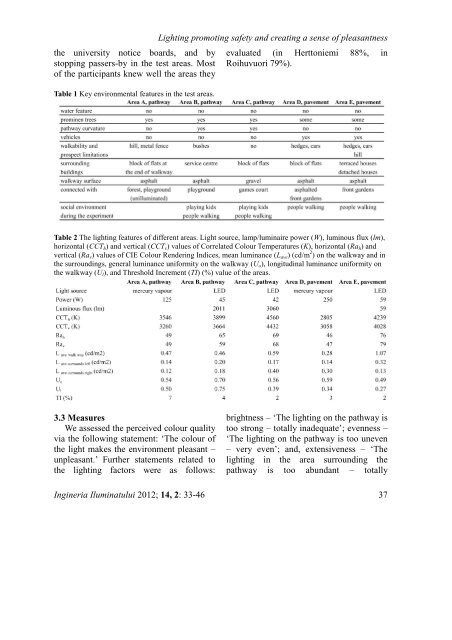Untitled - Journal of Lighting Engineering
Untitled - Journal of Lighting Engineering
Untitled - Journal of Lighting Engineering
Create successful ePaper yourself
Turn your PDF publications into a flip-book with our unique Google optimized e-Paper software.
the university notice boards, and by<br />
stopping passers-by in the test areas. Most<br />
<strong>of</strong> the participants knew well the areas they<br />
Table 1 Key environmental features in the test areas.<br />
<strong>Lighting</strong> promoting safety and creating a sense <strong>of</strong> pleasantness<br />
evaluated (in Herttoniemi 88%, in<br />
Roihuvuori 79%).<br />
Table 2 The lighting features <strong>of</strong> different areas. Light source, lamp/luminaire power (W), luminous flux (lm),<br />
horizontal (CCTh) and vertical (CCTv) values <strong>of</strong> Correlated Colour Temperatures (K), horizontal (Rah) and<br />
vertical (Rav) values <strong>of</strong> CIE Colour Rendering Indices, mean luminance (Lave) (cd/m 2 ) on the walkway and in<br />
the surroundings, general luminance uniformity on the walkway (Uo), longitudinal luminance uniformity on<br />
the walkway (Ul), and Threshold Increment (TI) (%) value <strong>of</strong> the areas.<br />
3.3 Measures<br />
We assessed the perceived colour quality<br />
via the following statement: ‘The colour <strong>of</strong><br />
the light makes the environment pleasant –<br />
unpleasant.’ Further statements related to<br />
the lighting factors were as follows:<br />
brightness – ‘The lighting on the pathway is<br />
too strong – totally inadequate’; evenness –<br />
‘The lighting on the pathway is too uneven<br />
– very even’; and, extensiveness – ‘The<br />
lighting in the area surrounding the<br />
pathway is too abundant – totally<br />
Ingineria Iluminatului 2012; 14, 2: 33-46 37
















